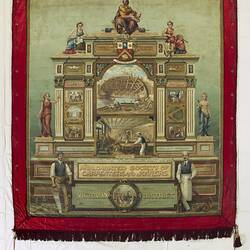Summary
Poster for community event to celebrate the 150th anniversary of the Eight Hour Day on April 21, 2006. The poster features a photograph taken by Ponch Hawkes titled 'The Waiter's Race'.
Action taken by stonemasons on 21 April 1856 led to the establishment of the Eight Hour Day, with the government agreeing that workers employed on public works should enjoy an eight hour day with no loss of pay. It was a world first and became emblematic of the rights of labour. In recognition of the significance of this achievement, April 21 was made a public holiday in 1879 and commemorative marches were held each year from 1879 until 1951. The Eight Hour Day holiday was renamed Labour Day in 1934. In 1955 the Labour Day march and celebrations were replaced by Moomba
Description of Content
Poster for community event to celebrate the 150th anniversary of the gaining of the Eight Hour Day, 21 April 2006. Featuring a photograph by Ponch Hawkes, 'The Waiter's Race'.
Physical Description
Printed poster, with black and white image and red and white text.
Significance
2006 marked the 150th anniversary of the Eight Hour Day in Victoria. Action taken by stonemasons on 21 April 1856 led to the establishment of the Eight Hour Day, with the government agreeing that workers employed on public works should enjoy an eight hour day with no loss of pay. It was a world first and became emblematic of the rights of labour.
Represented by the slogan 'eight hours labour, eight hours rest, eight hours recreation' and the intertwined numbers '888', the Eight Hour Day became a symbol of the rights of workers to organise to achieve their rights not only as workers, but as citizens in a democratic society.
Planning for the celebrations to mark the 150th anniversary commenced in mid 2003. The main program partners were Australian Centre for the Moving Image, Australian Society for the Study of Labor History, City of Melbourne, Heritage Victoria, Melbourne Workers Theatre, Museum Victoria, RMIT University, State Library of Victoria, University of Melbourne and Victorian Trades Hall Council. The final line-up for the program had 11 exhibitions, 3 theatrical shows, 2 conferences, a public forum, public lecture, 2 community events and a banquet.
More Information
-
Collecting Areas
-
Acquisition Information
Collected from Dr Richard Gillespie - Museum Victoria, 05 Dec 2006
-
Issued By
-
Organiser of Event
-
Organisation Named
-
Place & Date of Event
University of Melbourne, Grattan Street, Parkville, Greater Melbourne, Victoria, Australia, 21 Apr 2006
The event was held at the Old Law Quadrangle. -
Inscriptions
Printed in white text: 'Celebrate 150 years of work, rest and play/Come join the party!/Free Community Event on the 150th anniversary of the gaining of the Eight Hour Day/10am, Friday, 21 April 2006/Old Law Quadrangle, Melbourne University/www.8hourday.org.au'
-
Classification
-
Category
-
Discipline
-
Type of item
-
Overall Dimensions
335 mm (Width), 305 mm (Height)
-
References
Celebrate 888: Report on the Celebration of the 150th Anniversary of the Eight Hour Day, 2006, Museum Victoria, 2006
-
Keywords
8 Hours Day Movement, Trade Unions, 8 Hours Day Celebrations, Workers Rights, Waiters, Hospitality Workers, Making History - Eight Hour Day

